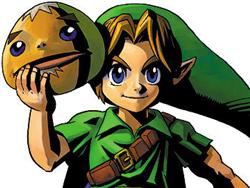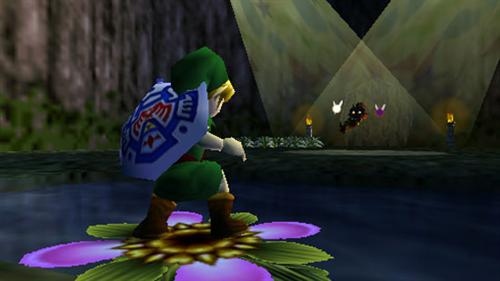 I’ve made no secret about my mad love for the Nintendo 64’s Majora’s Mask; I might even go as far to say that it is my favorite Zelda title. Why am I so infatuated with the game, though? The general consensus was that this Ocarina follow-up was OK, but it lacked the magic, the charm and the feel. I couldn’t disagree more, because Majora’s Mask was the darkest, most thematic and most engaging Zelda ever made.
I’ve made no secret about my mad love for the Nintendo 64’s Majora’s Mask; I might even go as far to say that it is my favorite Zelda title. Why am I so infatuated with the game, though? The general consensus was that this Ocarina follow-up was OK, but it lacked the magic, the charm and the feel. I couldn’t disagree more, because Majora’s Mask was the darkest, most thematic and most engaging Zelda ever made.
Let’s start with the beginning of the game, where a child Link is riding Epona through a forest, searching for a lost friend. Right away the game established the creepy tone, with a small boy, albeit well equipped for a fight, riding through a dark misty forest. The fact that you play as young Link is meant to make you feel powerless in some respects, particularly more so as you progress through the opening chapters. Adult Link is a favorite of gamers, so right away Nintendo might have alienated some Ocarina of Time fans.
Soon Link is beset upon by a strange being, also seemingly a child, wearing a purple and red mask covered in spikes. This is the Skull Kid, who promptly steals Link’s Ocarina and horse and leads him down a dark hole to another world. If this wasn’t bad enough, the Skull Kid then uses the power of the mask to turn Link into a Deku Scrub.
Helpless and trapped in an alien body, Link discovers that he is in the land of Termina in an alternate dimension. Lost, out of his own body and far from home, he also learns that the moon is set to crash into the main town in three days, obliterating everything. So begins Link’s twisting journey though time over the course of those three days, restoring the land to order so the mystical spirits of the world can halt the moon’s progress.
The moon is a central figure in Majora’s Mask, its downward progress inexorable, a constant reminder that you have a real chance of death hanging over your head. Whereas the threats of Ocarina always felt distant, something you could tackle at a whim, the moon in Majora’s Mask was always there, always reinforcing the very limited time of three short days. While those three days could be replayed over indefinitely, the world always came to an end when your time was up. This happened to me on my very first playthrough, and I was shocked at how casually the game would just kill you if you weren’t careful. While Dead Rising would repeat this convention several years later, it failed to establish the sense of dread the moon instilled in you.
Another central facet of Majora’s Mask is, of course, the various masks you found about the land. Some would do nothing, but most of them contained a power that would enable Link to become invisible, run faster, or transform into other species. While these were great boons, the transformation masks always made the change uncomfortable to watch. When Link placed the Zora or Goron mask on his face, it latched onto him, the game zooming into Link’s shocked face as the magic of the mask transfigured him. While Link never says a word in the game, that one expression speaks volumes about the pain inherent in transforming. As essential as these masks were to progressing through the game, you got the sense that Link wasn’t exactly enjoying it.
Masks are also very important to the people inhabiting Termina, and in order to gain the ultimate mask, the Fierce Deity Mask, you must do one of the most difficult side quests in gaming to gain the Couple’s Mask, which requires you to run all the way until the last possibly second in one go, something that most people found almost impossible. While the Fierce Deity Mask is a great reward, it shows how far the game made you go for an edge over bosses.
Music is also important in Majora’s Mask, perhaps even more so than it was in Ocarina of Time. Like Ocarina, the Song of Time alters the flow of time, but instead of jumping backwards and forwards seven years, it reverses time to the beginning of the three days. While this is limiting, it also gives you chance to prepare for the inevitable showdown with whatever is propelling the moon forward. Additionally, as the days tick by in the game, the music changes pace, a not-so-subtle reminder that time is quickly running out. Additionally, all of Link’s alternate forms possess their own unique instruments, and they are essential to each species’ side quests.
Majora’s Mask also featured a more involved, nuanced and mature story than Ocarina of time, one where Link would get involved in the politics of the various creatures he could transform into. Before Link could access each temple, he had to do various tasks for the species of the world, and they often involved dark undertones or were out of the norm. Even the main enemy of the game, the Skull Kid, is possessed by the power of the Mask, but acts seemingly of his own will. Again, nothing is as it seems, as the Mask appears to be a sentient entity with its own evil goals in mind.
 It may be the product of nostalgia, but Majora’s Mask had a far greater affect on me than Ocarina of Time. Ocarina was a fun adventure and an addicting game, but it didn’t capture me the way Majora’s Mask did. Maybe this is the rare case of a Nintendo sequel on the same console, and Nintendo felt that, with the base technology out of the way, they could try something different, play with the setting of Zelda. In this game, there is no princess, no Ganondorf, no Triforce; just you, a strange land and a catastrophe to stop. By peeling away the lays that made the game so recognizably Zelda, Nintendo created a game that was stronger than Ocarina of Time by proving that this franchise could stand without the familiar tropes to hold it up.
It may be the product of nostalgia, but Majora’s Mask had a far greater affect on me than Ocarina of Time. Ocarina was a fun adventure and an addicting game, but it didn’t capture me the way Majora’s Mask did. Maybe this is the rare case of a Nintendo sequel on the same console, and Nintendo felt that, with the base technology out of the way, they could try something different, play with the setting of Zelda. In this game, there is no princess, no Ganondorf, no Triforce; just you, a strange land and a catastrophe to stop. By peeling away the lays that made the game so recognizably Zelda, Nintendo created a game that was stronger than Ocarina of Time by proving that this franchise could stand without the familiar tropes to hold it up.
While you are still the hero of the land, it is much more difficult to do what you need to do. Majora’s Mask is not a straight run; it requires hours and hours of back tracking, especially if you want to go into the final battle totally prepared. This is a game that asked a lot from you in terms of patience and perseverance, and it paid dividends.
Perhaps this is just a case of having a lot of time on my hands when I was younger, but I was prepared to explore the world of Termina, captured at the outset by the outright failure I had brought upon myself by failing to get my Ocarina back from the Skull Kid and resetting time. The game had an absolute end with all sorts of ambiguity in the middle. Termina has never been explored since then, and that only added to the mystery. Why was there an alternate version of Hyrule? How did it come to be? We’ll never know, because as soon as Link saved that world, he went back to his own.
While I wouldn’t wish for a sequel to Majora’s Mask, I do acknowledge that the mystery only added to the game. If Nintendo ever wanted to get me back into Zelda wholeheartedly, they would need to step away from the Ocarina trap and try something daring. The refusal to do another princess-saving game was the coup de grace of Majora’s Mask, and for that I tip my hat to Nintendo. That game proves that, when they want to, they can blow the box wide open.
So, that’s kind of why I love Majora’s Mask. It’s difficult to put it into words after so many years, but I think I did an OK job conveying my adoration for this game. What about you guys? Any off-beat titles that have grabbed you in a similar way?


Great feature, Mitch! This is one Zelda game I’ve never managed to play. It’s interesting, because people seem to either love it or hate it. As much as I think people want new things out of the Zelda franchise at times, here we have an example of Nintendo breaking from the norm a bit and getting some mixed reactions because of it. I know a few people who claim this is their favorite Zelda title, though.
As a big fan of Majora’s Mask, I’d say you nailed what made it great. It took me a little while to warm up to the 3-day cycle mechanic, but ultimately it drew me in like no Zelda title before or since. As you mentioned, I think it was the dark undertones present throughout the game that really kept me intrigued (and occasionally creeped out).
This game holds a special place in my heart because it’s the game I got when I got my N64 for Christmas. Loved it, but I had to have the strategy guide to beat it. Also Mitch did you see the Skull Kid at PAX with the absolutely perfect replica of Majora’s Mask? That thing was amazing!
Mitch, you nailed this. Majora’s Mask was dark and bittersweet and I loved it.
Thanks for the comments, folks. Feels good to finally explain my weird tastes.
And no, SK, I don’t think I saw that at PAX. I kind of wish I did though.